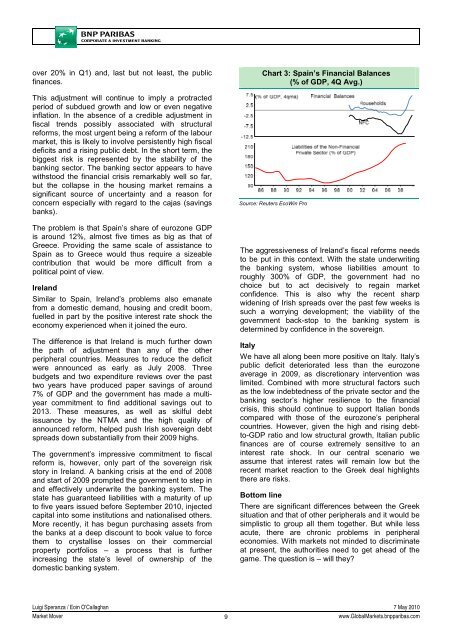Market Economics | Interest Rate Strategy - BNP PARIBAS ...
Market Economics | Interest Rate Strategy - BNP PARIBAS ...
Market Economics | Interest Rate Strategy - BNP PARIBAS ...
You also want an ePaper? Increase the reach of your titles
YUMPU automatically turns print PDFs into web optimized ePapers that Google loves.
over 20% in Q1) and, last but not least, the public<br />
finances.<br />
This adjustment will continue to imply a protracted<br />
period of subdued growth and low or even negative<br />
inflation. In the absence of a credible adjustment in<br />
fiscal trends possibly associated with structural<br />
reforms, the most urgent being a reform of the labour<br />
market, this is likely to involve persistently high fiscal<br />
deficits and a rising public debt. In the short term, the<br />
biggest risk is represented by the stability of the<br />
banking sector. The banking sector appears to have<br />
withstood the financial crisis remarkably well so far,<br />
but the collapse in the housing market remains a<br />
significant source of uncertainty and a reason for<br />
concern especially with regard to the cajas (savings<br />
banks).<br />
The problem is that Spain’s share of eurozone GDP<br />
is around 12%, almost five times as big as that of<br />
Greece. Providing the same scale of assistance to<br />
Spain as to Greece would thus require a sizeable<br />
contribution that would be more difficult from a<br />
political point of view.<br />
Ireland<br />
Similar to Spain, Ireland’s problems also emanate<br />
from a domestic demand, housing and credit boom,<br />
fuelled in part by the positive interest rate shock the<br />
economy experienced when it joined the euro.<br />
The difference is that Ireland is much further down<br />
the path of adjustment than any of the other<br />
peripheral countries. Measures to reduce the deficit<br />
were announced as early as July 2008. Three<br />
budgets and two expenditure reviews over the past<br />
two years have produced paper savings of around<br />
7% of GDP and the government has made a multiyear<br />
commitment to find additional savings out to<br />
2013. These measures, as well as skilful debt<br />
issuance by the NTMA and the high quality of<br />
announced reform, helped push Irish sovereign debt<br />
spreads down substantially from their 2009 highs.<br />
The government’s impressive commitment to fiscal<br />
reform is, however, only part of the sovereign risk<br />
story in Ireland. A banking crisis at the end of 2008<br />
and start of 2009 prompted the government to step in<br />
and effectively underwrite the banking system. The<br />
state has guaranteed liabilities with a maturity of up<br />
to five years issued before September 2010, injected<br />
capital into some institutions and nationalised others.<br />
More recently, it has begun purchasing assets from<br />
the banks at a deep discount to book value to force<br />
them to crystallise losses on their commercial<br />
property portfolios – a process that is further<br />
increasing the state’s level of ownership of the<br />
domestic banking system.<br />
Chart 3: Spain’s Financial Balances<br />
(% of GDP, 4Q Avg.)<br />
Source: Reuters EcoWin Pro<br />
The aggressiveness of Ireland’s fiscal reforms needs<br />
to be put in this context. With the state underwriting<br />
the banking system, whose liabilities amount to<br />
roughly 300% of GDP, the government had no<br />
choice but to act decisively to regain market<br />
confidence. This is also why the recent sharp<br />
widening of Irish spreads over the past few weeks is<br />
such a worrying development; the viability of the<br />
government back-stop to the banking system is<br />
determined by confidence in the sovereign.<br />
Italy<br />
We have all along been more positive on Italy. Italy’s<br />
public deficit deteriorated less than the eurozone<br />
average in 2009, as discretionary intervention was<br />
limited. Combined with more structural factors such<br />
as the low indebtedness of the private sector and the<br />
banking sector’s higher resilience to the financial<br />
crisis, this should continue to support Italian bonds<br />
compared with those of the eurozone’s peripheral<br />
countries. However, given the high and rising debtto-GDP<br />
ratio and low structural growth, Italian public<br />
finances are of course extremely sensitive to an<br />
interest rate shock. In our central scenario we<br />
assume that interest rates will remain low but the<br />
recent market reaction to the Greek deal highlights<br />
there are risks.<br />
Bottom line<br />
There are significant differences between the Greek<br />
situation and that of other peripherals and it would be<br />
simplistic to group all them together. But while less<br />
acute, there are chronic problems in peripheral<br />
economies. With markets not minded to discriminate<br />
at present, the authorities need to get ahead of the<br />
game. The question is – will they?<br />
Luigi Speranza / Eoin O’Callaghan 7 May 2010<br />
<strong>Market</strong> Mover<br />
9<br />
www.Global<strong>Market</strong>s.bnpparibas.com
















